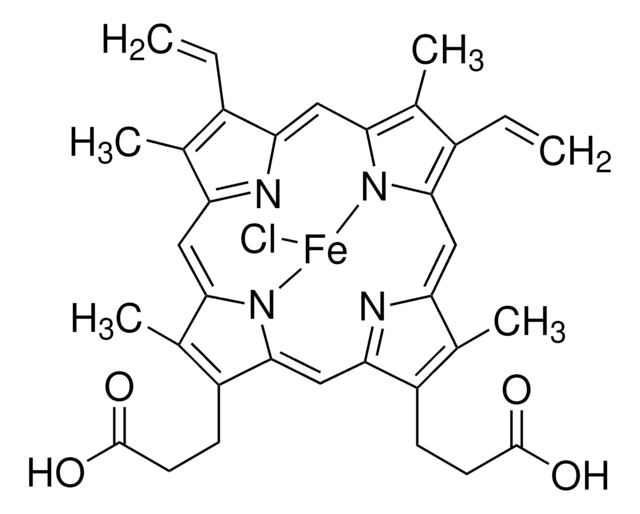おすすめの製品
品質水準
アッセイ
≥98% (HPLC)
形状
powder
保管条件
desiccated
色
white to tan
溶解性
DMSO: ≥25 mg/mL
オーガナイザー
Bayer
保管温度
2-8°C
InChI
1S/C21H24ClFN4O3/c1-14-11-26(12-15-2-5-17(23)6-3-15)8-9-27(14)20(28)13-30-19-7-4-16(22)10-18(19)25-21(24)29/h2-7,10,14H,8-9,11-13H2,1H3,(H3,24,25,29)/t14-/m1/s1
InChI Key
XQYASZNUFDVMFH-CQSZACIVSA-N
アプリケーション
BX471 has been used in chemotaxis assay to study the responses of HEK293 cells expressing human C-C motif chemokine receptor 1 (CCR1) to CC motif ligand 3 (CCL3)-induced cell migration. It has also been used as a CCR1 inhibitor to assess the effects of CCR1 on the migration and epithelial-mesenchymal transition (EMT).
生物化学的/生理学的作用
BX471 blocks CCR1 and downregulates the mRNA expression of ICAM-1, P-selectin and E-selectin. It decreases the inflammatory responses in sepsis, prevents monocyte recruitment in inflammation sites in rheumatoid arthritis patients and inhibits interstitial leukocyte recruitment and fibrosis in mouse model of lupus nephritis.
BX471 is an orally active, CCR-1 specific antagonist. It displaces the endogenous CCR-1 ligands MIP-1a, RANTES and MCP-3 (Ki range 1-5 nM). BX471 inhibits CCR-1 effects in leukocytes, including calcium mobilization and migration.
特徴および利点
This compound is featured on the Chemokine Receptors page of the Handbook of Receptor Classification and Signal Transduction. To browse other handbook pages, click here.
This compound was developed by Bayer. To browse the list of other pharma-developed compounds and Approved Drugs/Drug Candidates, click here.
保管分類コード
11 - Combustible Solids
WGK
WGK 3
引火点(°F)
Not applicable
引火点(℃)
Not applicable
適用法令
試験研究用途を考慮した関連法令を主に挙げております。化学物質以外については、一部の情報のみ提供しています。 製品を安全かつ合法的に使用することは、使用者の義務です。最新情報により修正される場合があります。WEBの反映には時間を要することがあるため、適宜SDSをご参照ください。
Jan Code
SML0020-5MG:
SML0020-VAR:
SML0020-25MG:
SML0020-BULK:
試験成績書(COA)
製品のロット番号・バッチ番号を入力して、試験成績書(COA) を検索できます。ロット番号・バッチ番号は、製品ラベルに「Lot」または「Batch」に続いて記載されています。
Human MSCs promotes colorectal cancer epithelial-mesenchymal transition and progression via CCL5beta-catenin Slug pathway
Chen K, et al.
Cell Death & Disease, 8(5), e2819-e2819 (2017)
Maria C Lebre et al.
PloS one, 6(7), e21772-e21772 (2011-07-13)
The aim of this study was to provide more insight into the question as to why blockade of CCR1, CCR2, and CCR5 may have failed in clinical trials in rheumatoid arthritis (RA) patients, using an in vitro monocyte migration system
The role of CCR1 and therapeutic effects of anti-CCL3 antibody in herpes simplex virus-induced Behccet's disease mouse model
Sayeed HM, et al.
Immunology (2019)
Hans-Joachim Anders et al.
Journal of the American Society of Nephrology : JASN, 15(6), 1504-1513 (2004-05-22)
Slowly progressive renal injury is the major cause for ESRD. The model of progressive immune complex glomerulonephritis in autoimmune MRL(lpr/lpr) mice was used to evaluate whether chemokine receptor CCR1 blockade late in the disease course can affect progression to renal
Nagarajan Vaidehi et al.
The Journal of biological chemistry, 281(37), 27613-27620 (2006-07-14)
A major challenge in the application of structure-based drug design methods to proteins belonging to the superfamily of G protein-coupled receptors (GPCRs) is the paucity of structural information (1). The 19 chemokine receptors, belonging to the Class A family of
資料
Sigma-Aldrich offers many products related to chemokine receptors for your research needs.
ライフサイエンス、有機合成、材料科学、クロマトグラフィー、分析など、あらゆる分野の研究に経験のあるメンバーがおります。.
製品に関するお問い合わせはこちら(テクニカルサービス)